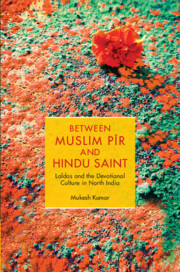Book contents
- Frontmatter
- Dedication
- Contents
- List of Figures, Maps and Tables
- Acknowledgements
- List of Abbreviations
- A Note on Transliteration
- Maps
- 1 The Spectre of Binaries
- 2 Laldas and Religious Duality of Pīr and Sant
- 3 The Laldas Shrines and Inter-religious Disputes
- 4 A Fait Accompli: The Complete Hinduisation of the Laldas Order
- 5 Religious Reform and Shared Shrines
- 6 Concealment and Secrecy: Hidden in Plain Sight
- 7 Poetic Response to Religious Puritanism
- 8 An Ephemeral Line in the Sand
- Appendices
- Glossary
- Bibliography
- Index
5 - Religious Reform and Shared Shrines
Published online by Cambridge University Press: 30 April 2024
- Frontmatter
- Dedication
- Contents
- List of Figures, Maps and Tables
- Acknowledgements
- List of Abbreviations
- A Note on Transliteration
- Maps
- 1 The Spectre of Binaries
- 2 Laldas and Religious Duality of Pīr and Sant
- 3 The Laldas Shrines and Inter-religious Disputes
- 4 A Fait Accompli: The Complete Hinduisation of the Laldas Order
- 5 Religious Reform and Shared Shrines
- 6 Concealment and Secrecy: Hidden in Plain Sight
- 7 Poetic Response to Religious Puritanism
- 8 An Ephemeral Line in the Sand
- Appendices
- Glossary
- Bibliography
- Index
Summary
During his regular Thursday visits to the Sufi tomb of the saint Shah Chokha, Ram Singh, a schoolteacher of the Baniya caste from the town of Punahana, never forgot to donate money to Tablighi Jamaat volunteers. He believed that visiting a Sufi dargāh and providing funds for Islamic education and mosque renovation were acts of service to God. Ram Singh lived close to the Laldas temple in Punahana (Figure 5.1). He or a member of his family visited the temple daily, either in the morning or evening. Ram Singh openly regarded Laldas as a Muslim, saying, hamāre bābā musalmān the par hamen unki pahcān se koi lenā denā nahī (our saint was Muslim, but we do not have any problem with his identity).
In 2015, the new temple of Laldas was built on the premises of an Arya Samaj school. The school building also served as a regional centre for the Arya Samaj. An open courtyard was located in front of the temple. Visitors arrived daily and waited in the courtyard while the Brahmin head priest, made the required arrangements for Laldas's morning and evening prayers. Most of the devotees were shopkeepers in the nearby central market in Punahana and came to the temple for quick prayers to the saint. This market was dominated by Hindus, particularly the Baniyas who owned shops for selling items of daily use. On the outer circle of this market, which separated Punahana from Nakanpur (a very old Meo village that is today part of the Punahana town municipality), there were shops for selling garments, mobiles, and vegetable and fruits, among other items. These shops were predominantly owned by Muslims.
The town was also home to considerable populations of Hindu ‘low castes’ such as Valmikis, Jatavs, Sainis (Malis), Nais and Punjabi immigrants from Pakistan. The everyday dynamics of social life in this town were significantly influenced by the presence of these communities. The demographic numbers of Hindus and Muslims were almost nearly the same, but the region had a Muslim majority. Hindus and Muslims interacted with one another, but there was a sense of insecurity among the Hindus, especially the Baniyas, due to the Muslim majority in the area. Hindu caste communities built strong networks with right-wing organisations such as the RSS, the Bajrang Dal and the Arya Samaj in response to their minority status, anticipating potential conflicts in the future.
- Type
- Chapter
- Information
- Between Muslim Pīr and Hindu SaintLaldas and the Devotional Culture in North India, pp. 135 - 161Publisher: Cambridge University PressPrint publication year: 2024
- Creative Commons
- This content is Open Access and distributed under the terms of the Creative Commons Attribution licence CC-BY-NC 4.0 https://creativecommons.org/cclicenses/

